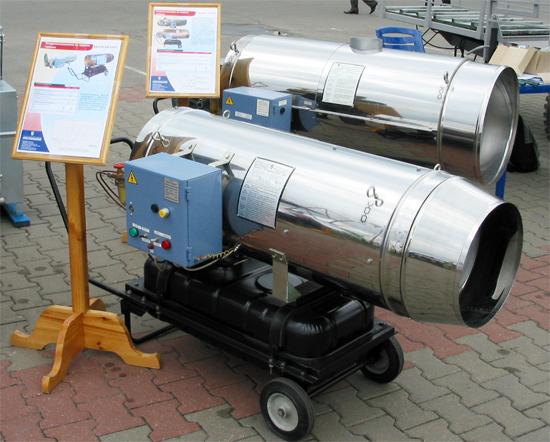Types of heat guns: usage, comparison, and efficiency.
Types of Heat Guns
Heat guns are industrial fan heaters used to warm up warehouses, workshops, and other utility spaces – basically, your workspace. There’s no big difference between heat guns and regular fan heaters. They work the same way, but differ in size and power. There are several types of heat guns: 1. Electric Heat Guns
They have a heating element (like a coil or tubular heater), a fan, and overheating protection. Some models include a special thermostat (capillary type) to automatically maintain the room temperature you set.
There are two types of heating elements:
- Nichrome coil – Low power (up to 10 kW), cheap but not very reliable.
- Tubular electric heater (TEN) – Lasts longer, works at lower temperature, and has a lower risk of fire.
2. Gas Heaters
These use liquefied gas as fuel. The gas flows through a nozzle where it mixes into a flammable blend. Electrodes then ignite it inside a sealed heat exchanger. Hot air moves through gaps between the exchanger walls and blows out. A piezo element triggers the ignition.
3. Diesel Heat Guns
They use direct heating (exhaust stays inside). Main pros: low price, easy to move, simple to use. Best for well-ventilated spaces like storage areas, farms, greenhouses, or construction sites.
Shape of Heat Guns
Two shapes exist – cylindrical and rectangular. Rectangular ones look better and can even be wall-mounted. They’re quiet and don’t disturb people working nearby. Cylindrical guns have small outlets but shoot air with more force.
Placement is key to efficiency. Good location helps spread heat evenly. You can also control the temperature with a thermostat or room-based controller. Fixed systems can connect to a mixer block to regulate fresh and indoor air. The built-in automation adjusts air vents over time.
Final tip: choose the right power for your space. For every 10 m², you need around 0.8–1.4 kW of power. This helps save energy and keep your space warm efficiently.
1. Electric Heat Guns
They have a heating element (like a coil or tubular heater), a fan, and overheating protection. Some models include a special thermostat (capillary type) to automatically maintain the room temperature you set.
There are two types of heating elements:
- Nichrome coil – Low power (up to 10 kW), cheap but not very reliable.
- Tubular electric heater (TEN) – Lasts longer, works at lower temperature, and has a lower risk of fire.
2. Gas Heaters
These use liquefied gas as fuel. The gas flows through a nozzle where it mixes into a flammable blend. Electrodes then ignite it inside a sealed heat exchanger. Hot air moves through gaps between the exchanger walls and blows out. A piezo element triggers the ignition.
3. Diesel Heat Guns
They use direct heating (exhaust stays inside). Main pros: low price, easy to move, simple to use. Best for well-ventilated spaces like storage areas, farms, greenhouses, or construction sites.
Shape of Heat Guns
Two shapes exist – cylindrical and rectangular. Rectangular ones look better and can even be wall-mounted. They’re quiet and don’t disturb people working nearby. Cylindrical guns have small outlets but shoot air with more force.
Placement is key to efficiency. Good location helps spread heat evenly. You can also control the temperature with a thermostat or room-based controller. Fixed systems can connect to a mixer block to regulate fresh and indoor air. The built-in automation adjusts air vents over time.
Final tip: choose the right power for your space. For every 10 m², you need around 0.8–1.4 kW of power. This helps save energy and keep your space warm efficiently.